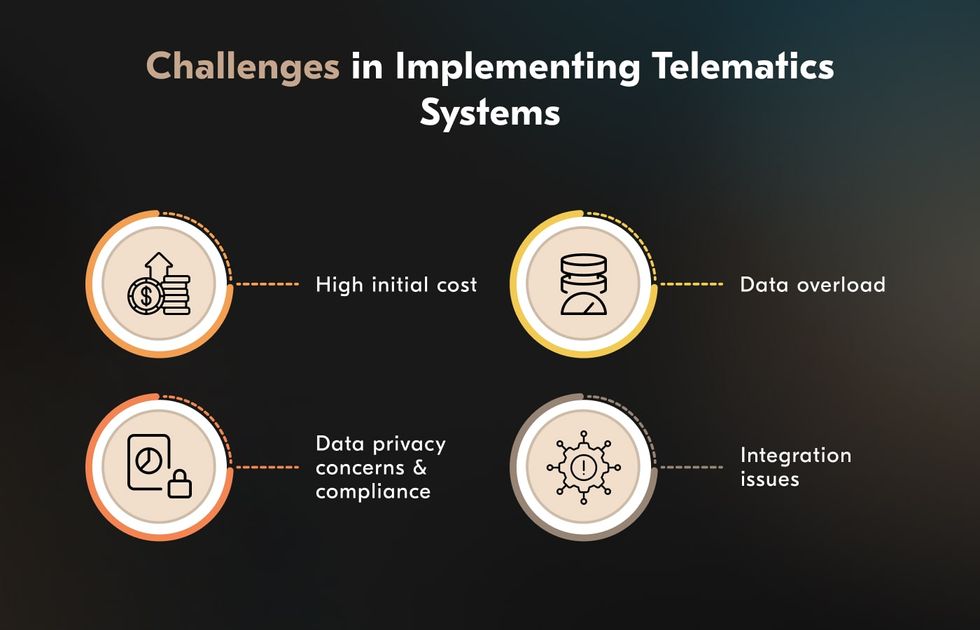
Key Takeaways
- Logistics telematics integrates telecommunications, IoT, and data analytics to enhance fleet management, providing real-time vehicle monitoring, predictive maintenance, and efficient route optimization.
- The global telematics market is projected to grow from $9.87 billion in 2024 to $17.24 billion by 2030, reflecting a CAGR of 9.84%.
- Telematics offers key advantages, including enhanced fleet efficiency through route optimization, safer driving practices via behavior monitoring, and cost savings with predictive maintenance.
- The technology benefits multiple sectors, including logistics, public transport, construction, cold chain management, and ride-sharing.
Transportation businesses now rely on advanced transport telematics to gather vast amounts of data from their fleets, enabling precise monitoring of vehicle conditions and performance. These systems generate comprehensive daily reports, providing invaluable insights for effective fleet management.
Often known as fleet tracking or GPS vehicle tracking, telematics has become a key tool for both commercial and government fleets. The growing demand is evident, with the global telematics market expected to reach $17.24B by 2030, surging from $9.87b in 2024.
As a well-recognized supply chain developer with a proven knack for custom logistics software, Acropolium has been discovering the latest tracking and data analysis technology.
In this guide, we delve into how telematics systems are used in transportation and their key features, challenges of implementation, and real-world use cases. Read on to see our own logistics software cases for successful tech adoption in your business!
What is a Transportation Telematics System?

No longer a logistics trend but an all-time classic, logistics telematics systems leverage the integration of telecommunications, computer science, and IoT technologies to transform fleet management.
These systems, widely adopted in managing commercial fleets, rely on advanced tools like GPS tracking and wireless devices to gather and transmit critical vehicle data.
Businesses integrate modern transportation telematics solutions to:
- Streamline vehicle deployment and enhance operational efficiency.
- Analyze data on vehicle diagnostics, fuel consumption, and driver behavior for informed decision-making.
- Use GPS-based tools to minimize transit times and reduce fuel costs.
- Simplify routine tasks to improve productivity and reduce human error.
- Achieve better resource utilization, lower operating expenses, and improved service quality.
Fleet management solutions now offer detailed insights into vehicle performance, driver behavior, and maintenance needs. Usage-based insurance models are driving growth in insurance telematics, rewarding safe drivers. Additionally, modern vehicles increasingly feature advanced navigation and infotainment systems, boosting demand for telematics integration.
Primary Benefits of Transportation Telematics Systems

Picture a transportation system that thinks ahead, learns from data, and adapts in real-time. Telematics systems, integrated into logistics apps, turn this vision into reality by offering an array of benefits tailored to modern fleet operations.
Improved Fleet Management
Transport fleet telematics enables operators to access real-time data on vehicle locations, performance, and conditions. This makes route optimization seamless, allowing vehicles to avoid delays and reduce mileage. The system also identifies inefficiencies, such as excessive idling or unnecessary detours, contributing to significant fuel savings.
With these tools, operators can manage fleets proactively, improving uptime and reducing operational bottlenecks.
Enhanced Driver Safety
Driver safety is at the core of transportation telematics solutions. The system continuously monitors risky behaviors, including speeding, harsh braking, and rapid acceleration, and provides actionable feedback to drivers and fleet managers. By promoting safer driving practices, telematics not only reduces the likelihood of accidents but also protects the company’s reputation and lowers insurance premiums.
Cost Optimization
Rising operational costs are a challenge for fleet managers, but advanced systems tackle this issue head-on. AI/ML and IoT-based monitoring ensure fuel is used efficiently, while predictive maintenance features identify potential vehicle issues before they lead to costly breakdowns.
By streamlining scheduling and reducing downtime, telematics cuts unnecessary expenses and improves overall profitability.
Better Customer Service
Customer expectations for accurate deliveries and real-time updates are higher than ever. Telematics transport tracking provides precise delivery time predictions and allows customers to track their orders with full transparency. This builds trust, enhances customer satisfaction, and creates a competitive edge for businesses.
Sustainability and Emissions Tracking
Environmental concerns are increasingly influencing business strategies, and cutting-edge technologies help companies align with these priorities. Transportation telematics systems monitor fuel consumption and emissions data so that operators can identify ways to reduce their carbon footprint.
Must-Have Features of Transportation Telematics Systems

Modern commercial vehicles increasingly come equipped with built-in telematics systems directly from manufacturers. For vehicles without these systems, aftermarket telematics devices are readily available. These devices, powered by either the vehicle’s battery or its internal electrical system, offer a versatile solution for integrating various telematics capabilities.
GPS Tracking
At the core of telematics for logistics, GPS tracking uses satellites, receivers, and GPRS networks to monitor vehicle locations in real-time. This technology enables precise navigation for drivers and allows managers to oversee vehicle routes and movements effectively.
GPS trackers can also be attached to trailers and other non-motorized assets to ensure their security and provide instant alerts if unauthorized movement occurs.
On-Board Diagnostics (OBD).
OBD systems gather critical data from the vehicle’s engine and components, enabling continuous monitoring of its condition. This allows fleet managers to plan preventive maintenance, track service records, and address potential issues before they lead to costly repairs.
Monitoring engine health and usage also ensures vehicles remain in optimal and safe working condition.
Communication Modules
These modules enable seamless transmission between telematics devices and centralized systems. By using cellular or satellite networks, communication modules relay real-time logistics & shipping fleet telematics data on vehicle status, location, and diagnostics to fleet managers.
This way, you can ensure timely decision-making and enhanced operational efficiency.
Logistics Platforms
Software platforms serve as the command center for telematics systems. They compile data from GPS, OBD, and IoT sensors, providing managers with actionable insights through intuitive dashboards.
Features like route optimization, driver behavior analytics, and maintenance scheduling empower fleet managers to improve productivity and reduce costs.
Sensors and Cameras
Advanced transport telematics comes with sensors and cameras to track a wide range of metrics, from fuel consumption and tire pressure to driving behaviors like speeding or harsh braking.
Cameras provide an additional layer of security by recording incidents and offering visual evidence in case of accidents, helping to mitigate risks and improve accountability.
Telematics in Transportation: Use Cases & Applications

Telematics technology reimagines fleet management worldwide, broadening the horizons of businesses of all sizes — from small local operators to global logistics giants.
This technology offers versatile applications across various industries, making it a vital tool for modern transportation challenges.
Route optimization in logistics and supply chain
Telematics optimizes logistics with the irreplaceable features of real-time tracking, route planning, and delivery time estimation. For instance, DHL uses telematics to monitor its fleet, reducing delivery times and improving fuel efficiency. They analyze GPS data and traffic patterns so that drivers receive optimized routes, minimizing delays and maximizing productivity.
Enhancing efficiency & safety in public transport
Public transport systems rely on telematics to improve route efficiency, monitor vehicle conditions, and ensure passenger safety. For example, Transport for London (TfL) uses telematic systems in transport apps to track buses in real-time, allowing dynamic adjustments to schedules and routes. The data also helps reduce fuel consumption and enhance safety by monitoring driver navigation, ensuring a smoother commute for passengers.
Tracking performance for construction vehicles
In the construction industry, telematics transport tracking plays a crucial role in monitoring heavy equipment and vehicles. Caterpillar’s telematics solution, Cat Connect, helps track machinery usage, fuel consumption, and maintenance needs.
This ensures projects stay on schedule and within budget while reducing downtime caused by equipment failures.
Temperature-sensitive cargo monitoring
Telematics ensures the integrity of temperature-sensitive shipments, such as pharmaceuticals or perishable goods. UPS uses cold chain-oriented transportation telematics solutions to monitor the temperature and location of its cold chain shipments. Sensors continuously send data to ensure optimal conditions, alerting managers to any deviations and preventing spoilage or loss.
Blockchain integration further strengthens cold chain management by creating an unalterable record of temperature data, enabling end-to-end traceability and boosting customer confidence in product quality.
Optimizing routes & reducing idle time in taxi services
Telematics is integral to ride-sharing platforms like Uber, where real-time GPS tracking ensures efficient route strategizing and reduced idle time. This allows drivers to respond quickly to ride requests, improving operational efficiency and enhancing the rider experience. Additionally, telematics data helps optimize surge pricing based on demand and supply patterns.
Managing rental vehicles & preventing misuse
Rental companies like Hertz use telematics transport monitoring software to manage their fleets, track vehicle usage, and prevent misuse. With features allowing users to monitor location, mileage, and driving behavior, the product helps improve maintenance schedules and ensure vehicles are returned in good conditions.
This results in cost savings and a better rental experience for customers.
Challenges in Implementing Telematics Systems

The successful implementation of telematics transportation tracking systems relies heavily on the expertise of skilled professionals in web development. Without careful planning and meticulous attention to detail, you can face significant risks and drawbacks, which we’re breaking down below.
High initial cost
One of the primary barriers to telematics adoption is the significant upfront investment required for hardware, software, and installation. From GPS devices and sensors to complex backend systems, the cost commitment can be daunting, especially if you’re developing a product from scratch.
Without a strategic budget plan, the risk of non-recoupment increases, making it critical to adopt a step-by-step project initiation process to ensure every dollar is spent productively.
Data privacy concerns & compliance
Since advanced transport telematics gathers extensive data, the technology critical issues around data privacy and compliance. Ensuring the protection of sensitive information and adhering to regional and global regulations, such as GDPR, can pose significant challenges.
Businesses must work with highly qualified specialists to design systems that prioritize robust data encryption, secure storage, and user access control.
Data overload
With telematics systems generating valuable insights, the sheer volume of data can overwhelm users without the right tools and processes to analyze and act upon it. Unfiltered data may lead to inefficiencies and missed opportunities as fleet managers struggle to extract meaningful patterns.
Implementing systematic testing, customizable TMS dashboards, and clear reporting protocols is essential to prevent the system from becoming a burden rather than a benefit.
Integration issues
Integrating telematics in logistics IT infrastructure is a technical challenge, notably if you’re operating with obsolete tools. Legacy systems may not be compatible with modern software, leading to inefficiencies and potential disruptions.
Developer support provided by your tech vendor will play a game-changing crucial role in addressing these challenges. Make sure that your web development partner enables you to gradually incorporate new functionalities with seamless communication between platforms.
Why choose Acropolium?
Acropolium delivers high-performance logistics software by combining expertise in SaaS, modern web architectures, compliance, and telematics. We address complex challenges in fleet management and logistics operations through innovative, scalable, and efficient solutions tailored to your needs.
From IoT-driven insights to custom fleet management software, our approach ensures every aspect of fleet management is optimized for success, which is reflected in one of our latest case studies:
- Our client needed an IoT-based vehicle tracking system with real-time data visualization and fleet management tools for mobile and desktop use. Our developers delivered a scalable solution supporting 1000 devices, integrating real-time tracking, data export, map visualization, and remote control features.
- The transport fleet telematics solution increased map capacity from 100 to 1000 vehicles.
- As a result, the client reduced reporting time from 4 days to 15-40 seconds for 1000 trucks.
Final Thoughts
Transportation telematics has transformed the industry with tools that enhance efficiency, safety, and decision-making. While the initial investment and data management challenges might stand in the way, the long-term benefits are undeniable.
From real-time fleet monitoring to optimizing cold chain logistics, telematics empowers businesses to innovate and stay competitive. As this technology advances, those adopting customized and scalable solutions will be well-positioned for success.
With 10 years of crafting unique TMS and tracking solutions, we are eager to take up new tech challenges to unlock the full potential of telematics and drive measurable results for you. Prioritizing your needs, we offer flexible subscription-based cooperation with your budget and business model in mind.











![Generative AI in Supply Chain Management: [Use Cases & Solutions]](/img/articles/generative-ai-supply-chain-solutions/img01.jpg)


![ᐉ Airport Operations Management Solftware [2025 Guide]](/img/articles/airport-operations-management/img01.jpg)